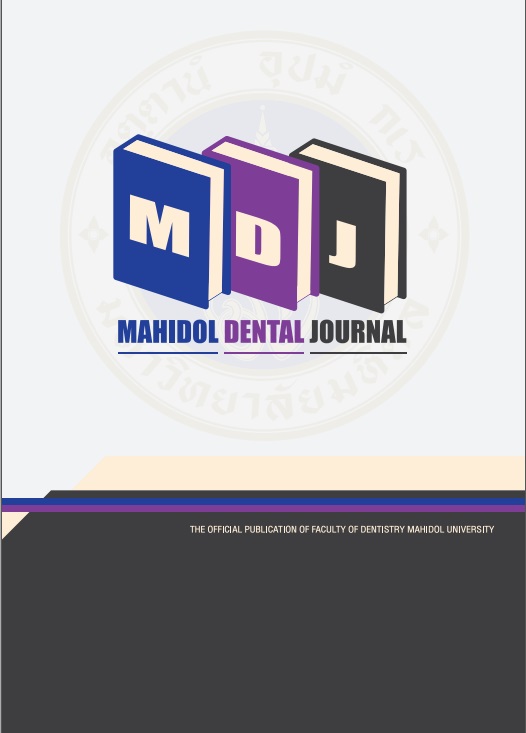Evaluation of the optimum brushing force on dental plaque removal: an in vitro study
Main Article Content
Abstract
Material and Methods: This in vitro study used seventy-two extracted bovine incisal teeth to evaluated an efficacy of plaque removal by automate brushing machine with toothbrush (divided into positive control group, negative control group and six testing groups, each group n=9). Streptococcus Mutans was incubated for 24 hours to formed bacterial plaque on enamel surface. Samples were stained with erythrosine red. Positive group was a maturation plaque stained and negative group was a plaque free sample with staining. Brushing test was performed by automatic brushing machine under a controlled condition. Loading force was applied from a minimum of 1 N, with an increment of 1 N to a maximum of 6 N. Sample’s focusing area photographs were used to interpreted a remaining percentage of red color in Red Green Blue system (RGB). Comparing mean difference by Welch’s ANOVA and Games Howell post hoc test.
Results: After testing with various brushing force, less percentage of red color remained when more force was performed. The 3 N group showed significantly less remaining red color than the positive control group but not significantly different from the negative control group (p<0.05). Less brushing force (1 N and 2 N group) showed significantly lower of remaining red color than the positive control group and significantly higher than the negative control group.
Conclusion: Brushing with 3N force was recommended for dental plaque removal from enamel surface by manual toothbrush.
Article Details
References
Loe H, Theilade E, Jensen SB. Experimental Gingivitis in Man. J Periodontal 1965; 36: 177-87.
Robinson PG, Deacon SA, Deery C, Heanue M, Walmsley AD, Worthington HV, et al. Manual versus powered toothbrushing for oral health. Cochrane Database Syst Rev 2005: CD002281.
Lang NP. Commentary: bacteria play a critical role in the etiology of periodontal disease. J Periodontal 2014; 85: 211-3.
Mouth Healthy: Brushing Your Teeth. Available at https://www.mouthhealthy.org/en/az-topics/b/brushing-your-teeth. Accessed on February 23, 2020 [Internet].
Piotrowski BT, Gillette WB, Hancock EB. Examining the prevalence and characteristics of abfractionlike cervical lesions in a population of U.S. veterans. J Am Dent Assoc 2001; 132: 1694-701.
Addy M, Hunter ML. Can tooth brushing damage your health? Effects on oral and dental tissues. Int. J. Dent 2003; 53 Suppl 3: 177-86.
Lussi A, Schaffner M. Progression of and risk factors for dental erosion and wedge-shaped defects over a 6-year period. Caries Res 2000; 34: 182-7.
Wood I, Jawad Z, Paisley C, Brunton P. Non-carious cervical tooth surface loss: a literature review. J Dent 2008; 36: 759-66.
Aw TC, Lepe X, Johnson GH, Mancl L. Characteristics of noncarious cervical lesions: a clinical investigation. J Am Dent Assoc 2002; 133: 725-33.
Lussi AR, Schaffner M, Hotz P, Suter P. Epidemiology and risk factors of wedge-shaped defects in a Swiss population. Schweiz Monatsschr Zahnmed 1993; 103: 276-80.
Radentz WH, Barnes GP, Cutright DE. A survey of factors possibly associated with cervical abrasion of tooth surfaces. J Periodontal 1976; 47: 148-54.
Poynter ME, Wright PS. Tooth wear and some factors influencing its severity. Restorative Dent 1990; 6: 8-11.
Grippo JO, Simring M, Schreiner S. Attrition, abrasion, corrosion and abfraction revisited: a new perspective on tooth surface lesions. J Am Dent Assoc 2004; 135: 1109-18; quiz 63-5.
Bader JD, McClure F, Scurria MS, Shugars DA, Heymann HO. Case-control study of non-carious cervical lesions. Community Dent Oral Epidemiol 1996; 24: 286-91.
Philpotts CJ, Weader E, Joiner A. The measurement in vitro of enamel and dentine wear by toothpastes of different abrasivity. Int J Dent 2005; 55: 183-7.
Brandini DA, de Sousa AL, Trevisan CI, Pinelli LA, do Couto Santos SC, Pedrini D, et al. Noncarious cervical lesions and their association with toothbrushing practices: in vivo evaluation. Oper Dent 2011; 36: 581-9.
AB G. The American textbook of operative dentistry. 8th ed. Philadelphia: Lea & Febiger; 1947.
Lussi A. Dental erosion clinical diagnosis and case history taking. Eur J Oral Sci 1996; 104: 191-8.
Burgett FG, Ash MM, Jr. Comparative study of the pressure of brushing with three types of toothbrushes. J Periodontal 1974; 45: 410-3.
Wiegand A, Burkhard JP, Eggmann F, Attin T. Brushing force of manual and sonic toothbrushes affects dental hard tissue abrasion. Clin Oral Investig 2013; 17: 815-22.
Voronets J, Lussi A. Thickness of softened human enamel removed by toothbrush abrasion: an in vitro study. Clin Oral Investig 2010; 14: 251-6.
Takehara J, Takano T, Akhter R, Morita M. Correlations of noncarious cervical lesions and occlusal factors determined by using pressure-detecting sheet. J Dent 2008; 36: 774-9.
Sehmi H, Olley RC. The effect of toothbrush abrasion force on dentine hypersensitivity in-vitro. J Dent 2015; 43: 1442-7.
Dyer D, Addy M, Newcombe RG. Studies in vitro of abrasion by different manual toothbrush heads and a standard toothpaste. J Clin Periodontol 2000; 27: 99-103.
Slot DE, Wiggelinkhuizen L, Rosema NA, Van der Weijden GA. The efficacy of manual toothbrushes following a brushing exercise: a systematic review. Int J Dent Hyg 2012; 10: 187-97.
Quigley GA, Hein JW. Comparative cleansing efficiency of manual and power brushing. J Am Dent Assoc 1962; 65: 26-9.
McCracken GI, Janssen J, Swan M, Steen N, de Jager M, Heasman PA. Effect of brushing force and time on plaque removal using a powered toothbrush. J Clin Periodontol 2003; 30: 409-13.
Van der Weijden GA, Timmerman MF, Danser MM, Van der Velden U. Relationship between the plaque removal efficacy of a manual toothbrush and brushing force. J Clin Periodontol 1998; 25: 413-6.
Yassen GH, Platt JA, Hara AT. Bovine teeth as substitute for human teeth in dental research: a review of literature. J Oral Sci 2011; 53: 273-82


